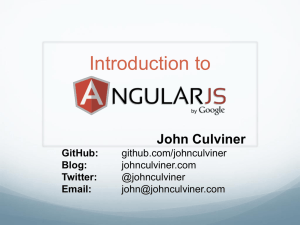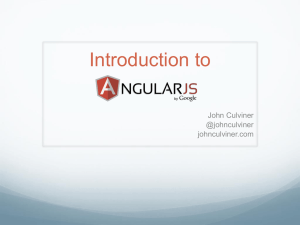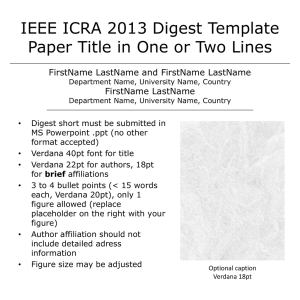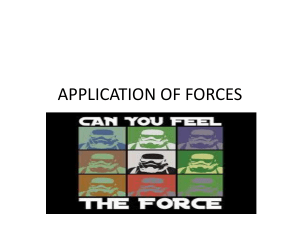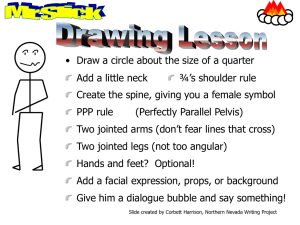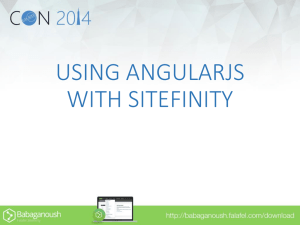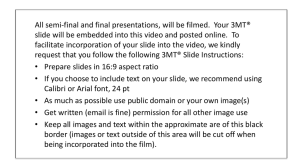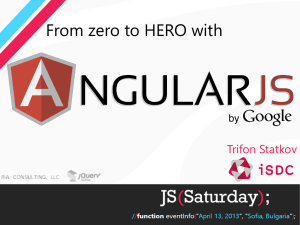Intro To AngularJS Slide Deck
advertisement
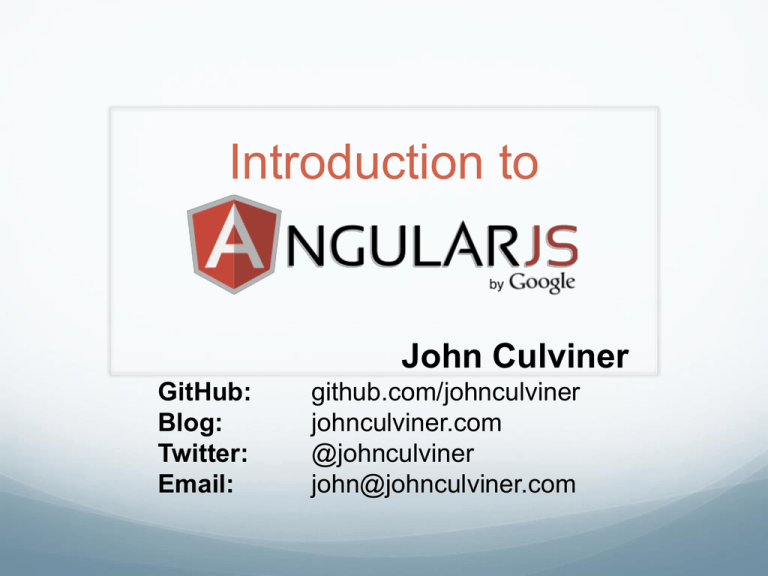
Introduction to
John Culviner
GitHub:
Blog:
Twitter:
Email:
github.com/johnculviner
johnculviner.com
@johnculviner
john@johnculviner.com
About Me
Angular, JavaScript & .NET Consultant @ ILM
Been developing on .NET professionally ~6 years
Heavy JavaScript development ~4 years
Manual, jQuery, Knockout.js, Durandal.js, Angular.js
SPA development ~3 years
Open Source Street Cred
jQuery File Download
FluentKnockoutHelpers
AngularAgility
A set of useful Angular.js extensions implementing common
UX patterns to improve productivity
What is Angular.js
Overview
Why should I care about Angular.js?
Angular.js features vs. other libraries
Why I like Angular.js / Didn't like Angular.js
Building a new social media site - FaceFolio
$scope
Directives
Controllers
Forms/Validation
Ajax with $http/$resource
Messaging with $scope .$emit/.$broadcast and .$on
Building a simple directive
Open Source AngularAgility project overview
Objective: you leave today feeling like you can start using
Angular.js right away
What is
?
An MVC framework for efficiently creating dynamic
views in a web browser (using “HTML” and JavaScript)
Some highlights/focuses:
Complete application framework
From ‘jQuery replacement’ to a massive ‘enterprise’ SPA
Fully dynamic MVVM with POJOs
Low level-DOM manipulation/markup invention with
directives and templates
AJAX / REST API interaction
Code organization, dependency injection, testability
Comprehensive SPA and routing support
Why should I care?
It's open source
Actively developed by Google
Google is paying devs to actively develop Angular
Actively developed by open source community (on
GitHub)
Angular.js #1?
Angular.js appears to be winning the JavaScript
framework battle
(and for good reason)
Lets see some evidence…
Why care? – Google trends
As of 4/3/2014
Why care? – GitHub Stats
As of 4/3/2014
Angular
Ember
Backbone
Knockout
Stars
22,351
9,780
17,538
4,821
Watches
2,225
828
1,455
425
Forks
7,144
2,109
3,851
799
Commits
past month
859
266
123
89
Authors
past month
195
58
25
9
Major
Releases
past year
21
15
3
4
Angular.js vs other libraries
vs
jQuery is a library meant for is DOM manipulation,
animations and an AJAX wrapper. NOT an application
framework
Pros
None. Angular has built in ‘basic’ jQuery.
If full-blown jQuery is added Angular will automatically
use it. Generally full blown NOT needed.
Cons
Horrible choice for creating dynamic UIs.
Verbose code, hard to maintain, not organized
Not MVVM or MVC
vs
Provides structure to web applications as well as model, view,
templating, basic routing and RESTful interactions.
Pros
Older and more mature
Cons
“Previous generation” web app framework
No MVVM w/o addons – use jQuery for DOM manip.
No DI, not as easily testable
Not a full-featured framework, meant to be ‘light’
Extremely verbose for what you get
Not actively developed
vs
A library that provides MVVM data bindings using observables
and dependency tracking
Pros
Possibly more performant under some situations
Not in my experience however
Cons
Complicated and error prone
Dependency tracking, computeds get confusing
“when complicated things break it's hard to figure out why”
No POJO. Have to create “types” and ko.observable()s
All it does is MVVM, not an app framework
Testability, code organization etc. all potential issues
vs
A full-fledged framework for web applications
Pros
Similar goals as Angular.js
Cons
Uses observables, special objects, string getters and
setters, not dynamic
Is ideal for LARGE web apps. Not intended for one off
jQuery replacements
Is arguably more complicated
Very opinionated, have to use their object "bases"
Not as popular as Angular
Why I like Angular best
1. FLEXIBLE! As big or small as you want it to be
Two line jQuery replacement to a MASSIVE enterprise app
2. POJOs make life so easy. No ‘observables’, wrappers etc. Uses
dirty checking for 2-way binding.
Fully embraces the dynamic nature of JavaScript
3. The community and popularity
4. Super efficient
5. DI, services, factories, providers offer flexibility and familiarity to
traditionally server side paradigms
6. Directives offer DSL-like extension to HTML for your domain
specific use cases
7. Scopes, although tricky, offer extreme flexibility
Why I don't didn't like Angular
Scopes are hard
initially, but
awesome
Learning curve ===
eventual
productivity
Live Coding time!
A simple example
<blink>Please Help!</blink>
Simple example
ng-app attribute causes Angular to scan children for
recognized tokens
Creates the “root scope” $rootScope
$rootScope ≈ a ViewModel
Angular sees three “directives”
{{firstName + " " + lastName}}
Evaluated against the current $rootScope and updates the
DOM on any change. "1 – way bound"
ng-model="firstName"
An input to be 2-way bound against $rootScope.firstName
ng-model="lastName"
An input to be 2-way bound against $rootScope.lastName
Original $rootScope:
$rootScope = {};
After typing:
$rootScope = {
firstName: “John”,
lastName: “Culviner”
};
• Object fields and values are
dynamically assigned by the bound
directives.
Directives
Perform the 1 or 2 way binding between the DOM
and the model ($rootScope)
• {{firstName + " " + lastName}}
• Watch for $scope changes and
reevaluate the expression
• ng-model="firstName"
• Watch for $scope.firstName
changes, update the textbox
• Watch for textbox changes,
update $scope.firstName
• ng-model="lastName"
• Watch for $scope.lastName
changes, update the textbox
• Watch for textbox changes,
update $scope.lastName
What is Scope?
Scope is an object that refers to the application model. It is an
execution context for expressions. Scopes are arranged in
hierarchical structure which mimic the DOM structure of the
application. Scopes can watch expressions and propagate events.
(from Angular website)
Key points
Scope is like a ViewModel that allows communication between
JavaScript code and Views
{{firstName + " " + lastName}} is an expr executed against scope
Scope can be hierarchal with DOM nesting of directives
Watches can be used to watch for changes to scope ex:
$scope.$watch("firstName", function(value) {
//update the DOM with the new value
});
What is a Directive?
A reusable component for performing DOM interaction, templating
and possibly two-way binding against $scope
The ONLY place JS to DOM interaction should occur
Angular offers a huge amount of built in directives for common UI
tasks, ex:
<div ng-show="someBool">someBool is true!</div>
2 way binding inputs, setting classes, foreach loops of elements,
clicking etc.
You can write your own directives
for domain specific purposes
(a ‘DSL’ for HTML). Ex:
<slideshow title="Shocked Cats">
<slide src="cat1.jpg"></slide>
<slide src="cat2.jpg"></slide>
…
</slideshow>
What is a Directive?
Or simply invoke an existing jQuery plugin
<datepicker ng-model="aDate"></datepicker>
Or if you need <=IE8 support:
<input type="text" datepicker="" ng-model="aDate"/>
Wrappers for jQuery UI components (ex: datepicker)
HUGE amount of directives out there due to Angular's popularity.
Rarely have to write your own other than domain specific
directives
EX: AngularUI
Twitter bootstrap wrappers
Select2
Sorting
Input masking
Enhanced router
Etc…
AngularAgility (my open source project)
A set of useful Angular.js extensions implementing common UX patterns to
improve productivity
Adding "status updates" with
a Controller
What is a Controller?
A controller is really just a fancy name for a
"scope container" that prototypically inherits from its
parent scope container.
A controller can interact with $scope (the 'view model')
which the view can also interact with.
$rootScope = {
Person Controller
$scope = {
firstName: "John",
lastName: "Culviner",
statuses: [{…}, {…}, …]
}
}
Directives and Scope
A controller is
really a directive
that is configured
to prototypically
inherit from its
parent
$rootScope = {
DIRECTIVE that prototypically
inherits from $rootScope
Person Controller
$scope = {
firstName: "John",
Directives can be
DIRECTIVE
ng-model="firstName" / "lastName"
• Each use parent scope, no inheritance
configured for
what type of
scope they create
and parent
access they have
lastName: "Culviner",
statuses: [
{ text: "foo", date: …},
DIRECTIVE
ng-repeat="status in statuses"
• Each record gets its own scope that
prototypically inherits from Person Controller
scope
Use "AngularJS
Batarang" plugin for
Chrome to explore
scopes
{ text: "bar", date: …}
]
}
Fixing the ugly dates and
ordering with Filters
What is a Filter?
A function that transforms an input to an output
Reminds me a lot of LINQ extension method lambdas in .NET
Can be "piped" UNIX style
Can create own
Angular has many built in filters:
currency
date
filter
json
limitTo
lowercase
number
orderBy
uppercase
Validation with ng-form
What is ng-form?
NOT a traditional HTML "form"
Requires a "name" and "ng-model" on each input you wish to
validate
Angular will not push invalid values back into bound $scope
Allows for validation of collections of controls
Applies CSS classes to elements based on their validity
Lots of built in validator directives that work with ng-form:
required=""
ng-minlength="{number}"
ng-maxlength="{number}"
ng-pattern="{string}"
Angular UI has some extensions
AngularAgility - FormExtensions makes it easier
Facefolio Progresses....
Lets check it out
Facefolio Progresses…
A REST API around people and statuses has been created
People
GET '/people' – get all the people in the DB
POST '/people' – save a new person
POST '/people/:id' – save existing person with :id
Statuses
GET '/statuses' – get all statuses in the DB
GET '/people/:id/statuses' – get all statuses for person
POST '/people/:id/statuses' – save person status
DELETE '/people/:id/statuses/:statusId' – delete a
particular status
Facefolio Progresses…
File structure has been laid out more sensibly
By functional area, NOT by type (like MVC)
index.html – main layout with left navigation and top header
/app
/person
person.html
person.js
/statusFeed
statusFeed.html
statusFeed.js
app.js – app module definition, routing configuration
index.js – controller code for index.html
Facefolio Progresses…
Is now a Single Page App (SPA) with multiple "virtual
pages"
The hash changes but DOESN'T cause a full DOM
refresh
Data loaded in with AJAX and JSON
Handled by AngularUI - Router
$resource
for status CRUD
$scope .emit/.on
for person name change
$rootScope = {
Index Controller
$scope = {
people: [{},{},{}]
DIRECTIVE (RENDERING HTML!)
ng-repeat="person in people"
John Culviner
Jane Doe,
John Doe
Person Controller
$scope: {
person: {
firstName: "John",
lastName: "Culviner
}
updatePerson: function()
{
//save a person
}
}
}
}
$scope .emit/.on
Scopes can "message" parent/child
scopes
$scope.$emit(…)
Message upward
$scope.$broadcast(…)
Message downward
Hey
someone Here:
When a person changes
changed!
Notify the "Index" controller to
Refresh!
refresh it's list (which has now
changed)
fieldLocker Directive
AngularAgility
A set of useful Angular.js extensions implementing
common UX patterns to improve productivity
#1 Goal: Reduce/remove the maundane "every
CRUD app I've made needs this stuff" code
#2 Goal: Configurability
AngularAgility Form Extensions
Generate Angular.js form fields, labels and rich
validation messages with error notifications in one line
of HTML
A 'DSL' for Twitter Bootstrap (or whatever) because the markup
is super verbose!
Drastically reduce boilerplate HTML for form fields and
validation messages
Automatic form field validation message generation
Form changed tracking, form resets, loading indicators,
on-navigate away handling
ANGULAR AGILITY
DEMO SITE
Questions/Comments?
John Culviner
GitHub:
Blog:
Twitter:
Email:
github.com/johnculviner
johnculviner.com
@johnculviner
john@johnculviner.com
FACEFOLIO CODE HERE:
https://github.com/johnculviner/IntroToAngularJS
ANGULAR AGILITY CODE HERE:
https://github.com/AngularAgility/AngularAgility

